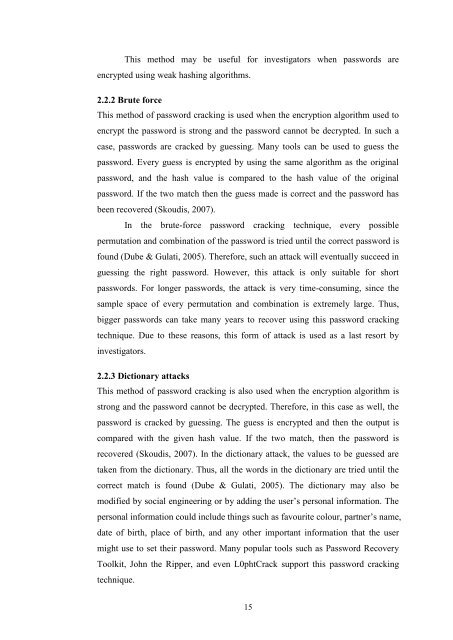Cracking Passwords in Forensic Investigations - Scholarly ...
Cracking Passwords in Forensic Investigations - Scholarly ...
Cracking Passwords in Forensic Investigations - Scholarly ...
You also want an ePaper? Increase the reach of your titles
YUMPU automatically turns print PDFs into web optimized ePapers that Google loves.
This method may be useful for <strong>in</strong>vestigators when passwords are<br />
encrypted us<strong>in</strong>g weak hash<strong>in</strong>g algorithms.<br />
2.2.2 Brute force<br />
This method of password crack<strong>in</strong>g is used when the encryption algorithm used to<br />
encrypt the password is strong and the password cannot be decrypted. In such a<br />
case, passwords are cracked by guess<strong>in</strong>g. Many tools can be used to guess the<br />
password. Every guess is encrypted by us<strong>in</strong>g the same algorithm as the orig<strong>in</strong>al<br />
password, and the hash value is compared to the hash value of the orig<strong>in</strong>al<br />
password. If the two match then the guess made is correct and the password has<br />
been recovered (Skoudis, 2007).<br />
In the brute-force password crack<strong>in</strong>g technique, every possible<br />
permutation and comb<strong>in</strong>ation of the password is tried until the correct password is<br />
found (Dube & Gulati, 2005). Therefore, such an attack will eventually succeed <strong>in</strong><br />
guess<strong>in</strong>g the right password. However, this attack is only suitable for short<br />
passwords. For longer passwords, the attack is very time-consum<strong>in</strong>g, s<strong>in</strong>ce the<br />
sample space of every permutation and comb<strong>in</strong>ation is extremely large. Thus,<br />
bigger passwords can take many years to recover us<strong>in</strong>g this password crack<strong>in</strong>g<br />
technique. Due to these reasons, this form of attack is used as a last resort by<br />
<strong>in</strong>vestigators.<br />
2.2.3 Dictionary attacks<br />
This method of password crack<strong>in</strong>g is also used when the encryption algorithm is<br />
strong and the password cannot be decrypted. Therefore, <strong>in</strong> this case as well, the<br />
password is cracked by guess<strong>in</strong>g. The guess is encrypted and then the output is<br />
compared with the given hash value. If the two match, then the password is<br />
recovered (Skoudis, 2007). In the dictionary attack, the values to be guessed are<br />
taken from the dictionary. Thus, all the words <strong>in</strong> the dictionary are tried until the<br />
correct match is found (Dube & Gulati, 2005). The dictionary may also be<br />
modified by social eng<strong>in</strong>eer<strong>in</strong>g or by add<strong>in</strong>g the user‘s personal <strong>in</strong>formation. The<br />
personal <strong>in</strong>formation could <strong>in</strong>clude th<strong>in</strong>gs such as favourite colour, partner‘s name,<br />
date of birth, place of birth, and any other important <strong>in</strong>formation that the user<br />
might use to set their password. Many popular tools such as Password Recovery<br />
Toolkit, John the Ripper, and even L0phtCrack support this password crack<strong>in</strong>g<br />
technique.<br />
15

















